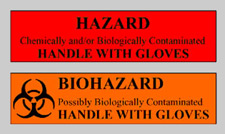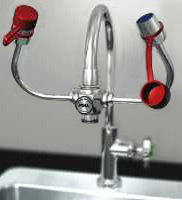Home | Glossary | Resources | Help | Contact Us | Course Map
Archival Notice
This is an archive page that is no longer being updated. It may contain outdated information and links may no longer function as originally intended.
Biohazards
Appropriate biohazard precautions and labeling should be applied to any evidence-bearing biological material collected from a crime scene and submitted to the forensic laboratory. This ensures compliance with Occupational Safety and Health Administration (OSHA) regulations and protects laboratory personnel.
Laboratory policies and procedures for handling biohazardous material should be followed.
Typical policies and procedures include these:
- Treating all evidence ammunition components as a potential biohazard
- Applying biohazard labels if this has not been done previously
- Air drying bloody evidence items in a fume hood prior to examination
- Wearing appropriate personal protective equipment (PPE) such as laboratory coats, masks, eye protection, and gloves when performing examinations
- Disinfecting fired evidence bullets with denatured alcohol or a 10 percent solution of bleach
- Removing encrusted blood and tissue from evidence ammunition components
Chemicals
Good laboratory practice dictates the use of appropriate precautions while working with chemicals to prevent inhalation, ingestion and/or skin contact. Laboratory policies and procedures for handling chemicals should be followed.
Typical policies and procedures include these:
- Laboratory ventilation
- Personal protective equipment (PPE), including laboratory coats, protective gloves, and eyewear
- Fume hoods
- Chemical spill kits
- Eye wash stations
- Hand wash stations
- Proper storage of prepared chemicals and test media
Additional Online Courses
- What Every First Responding Officer Should Know About DNA Evidence
- Collecting DNA Evidence at Property Crime Scenes
- DNA – A Prosecutor’s Practice Notebook
- Crime Scene and DNA Basics
- Laboratory Safety Programs
- DNA Amplification
- Population Genetics and Statistics
- Non-STR DNA Markers: SNPs, Y-STRs, LCN and mtDNA
- Firearms Examiner Training
- Forensic DNA Education for Law Enforcement Decisionmakers
- What Every Investigator and Evidence Technician Should Know About DNA Evidence
- Principles of Forensic DNA for Officers of the Court
- Law 101: Legal Guide for the Forensic Expert
- Laboratory Orientation and Testing of Body Fluids and Tissues
- DNA Extraction and Quantitation
- STR Data Analysis and Interpretation
- Communication Skills, Report Writing, and Courtroom Testimony
- Español for Law Enforcement
- Amplified DNA Product Separation for Forensic Analysts



